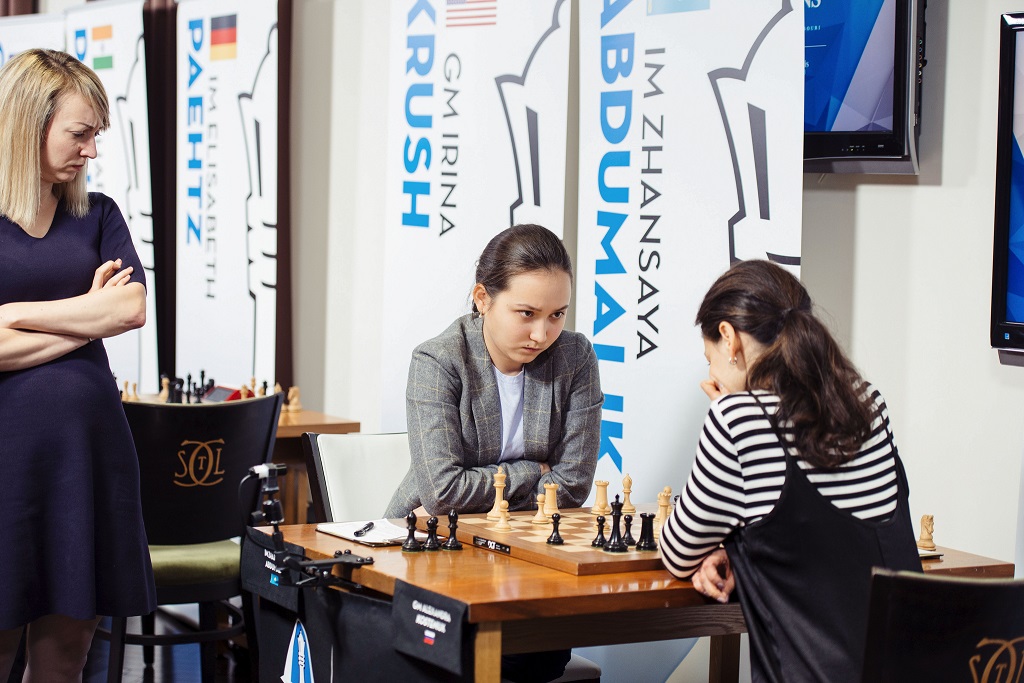


Former women's world champion Alexandra Kosteniuk displayed two of her greatest strengths in the game against Zhansaya Abdumalik: great preparation and a natural feel for tactical positions. When in form, the 34-year-old Russian has proven to be extremely dangerous while dealing with complex positions. And that is precisely what her young opponent had to face on Friday — a well-prepared Kosteniuk in a difficult Arkhangelsk variation of the Ruy Lopez.
Abdumalik started taking longer thinks from move eight, while Kosteniuk kept blitzing moves until move thirteen. Already with the initiative in her hands, Alexandra materialised her advantage capturing on h3:
The key difference in the position lies in the fact that White's light-squared bishop is boxed in by her own e4-pawn, while Black's knight, bishop and queen are placed actively. Thus, Kosteniuk was able to play 22...♝xh3, as Zhansaya cannot capture the piece due to 23.gxh3 ♛xd4 24.♕xd4 ♞f3+, with a royal fork.
Black was better and kept putting pressure, but the young Kazakh defended stubbornly until reaching a position the computer evaluated as close to equal. Nonetheless, time was not on Zhansaya's side, and Kosteniuk kept finding tactical resources:
White's bishop is now open and material is even, but the initiative is on Black's side and Zhansaya's king is in trouble. And, as they say, tactics crown good positional play — Kosteniuk captured with 30...♛xe5, taking advantage of White's weak back rank. Abdumalik fought on until move 38, when it was clear that not even a miracle would save her position.

Zhansaya's stare could not stop Kosteniuk | Photo: Austin Fuller / Saint Louis Chess Club
Two games finished rather quickly in round three: Valentina Gunina stopped trying to get something against a solid Petroff Defence put forth by Harika Dronavalli on move 31, while Elisabeth Paehtz got her first half point in Saint Louis against Irina Krush's Sicilian. The other two games, however, featured fierce fights.

Krush and Paehtz share a laugh | Photo: Lennart Ootes / Saint Louis Chess Club
Nana Dzagnidze played a Rossolimo Sicilian against Marie Sebag and achieved a big spatial advantage in the early middlegame. The French player reacted by giving up a knight for two pawns in order to free her position:
After 18...♞bxd5 19.exd5 ♞xd5 the computer thinks White has a large advantage, but when Sebag strengthened her pawn centre with 21...f5 it was clear that Nana needed to be careful on the kingside. By move 34, White had her bishops and rooks neatly lined up on the back rank:
Black's queen is threatened and 34...f4 seems to be the most natural response, but it allowed White to untangle with 35.♘xf4 ♜xf4 36.g3 — after the knight capture, Marie had 35...♛e5 keeping the tension, albeit White would play 36.g3 anyway, recovering control.
In the game, White was left with a considerable material advantage, but had to keep playing until move 70 to get her opponent to resign.

Nana kept her cool and won the game | Photo: Lennart Ootes / Saint Louis Chess Club
The other Georgian in the field, Bela Khotenashvili, used a Benoni setup against Anna Zatonskih. The players followed theory until move thirteen but started taking long thinks before that. Anna used her typical positional style and got a better-looking position in the early middlegame. Bela saw it necessary to give up a pawn on the queenside:
With 31...a5, Black prevents her opponent from freely using her initiative on the queenside. Bela tried to get the initiative in the centre, but Zatonskih calmly neutralised all Black's attempts until simply finding herself up material in an endgame. Resignation came on move 52, when there is no way to stop White's d-pawn from queening:
Black cannot play 52...♚f6 due to 53.g5#, so 52...♝xd6 is an only move, but then the d-pawn's advance is decisive.

Anna Zatonskih | Photo: Lennart Ootes / Saint Louis Chess Club
Saturday's round four will see Kosteniuk facing Sebag with the white pieces, while a highlight will certainly be the all-American clash between Krush and Zatonskih, who have fought for the national title repeatedly during the last fifteen years.
Commentary by GM Yasser Seirawan, GM Maurice Ashley and WGM Jennifer Shahade
Elisabeth Paehtz conceded her second defeat in the second round of the Cairns Cup. The other four games ended in draws, but twice a clear win was missed.
In the top game of the second round, two winners of round one met: Irina Krush and Valentina Gunina. The Russian GM was completely winning with the black pieces after Krush was forced to give up the exchange. The American had to go for a desperate kingside attack. But somehow it worked!
With 44...♛b2 (or ♛a2) Black could still have clarified the situation: 45.♕f7 ♜h2 46.♔g4 ♛e2+ and wins. Instead, Black went for a queen exchange 44...♛c1 immediately and White found considerable counterplay 45.♘f8+ ♚g8 46.♘xe6 etc. an endgame in which she had little to no edge and had to tread carefully to even make a draw.
A smooth winning chance was also missed by Anna Zatonskih against Alexandra Kosteniuk.
The white king is in a precarious spot on f4. Black played 32...g6 and the game ended drawn just nine moves later. However, after 32...♞c2 33.♖ac1 ♜8d4+ 34.♔g3 ♞e3 Kosteniuk would have threatened checkmate with 35...♞f5. White loses the f5-pawn with no compensation and has a miserable position to boot.

Alexandra Kosteniuk and Anna Zatonskih discuss the game | Photo: Austin Fuller
Click or tap any result to open the game in live.chessbase.com